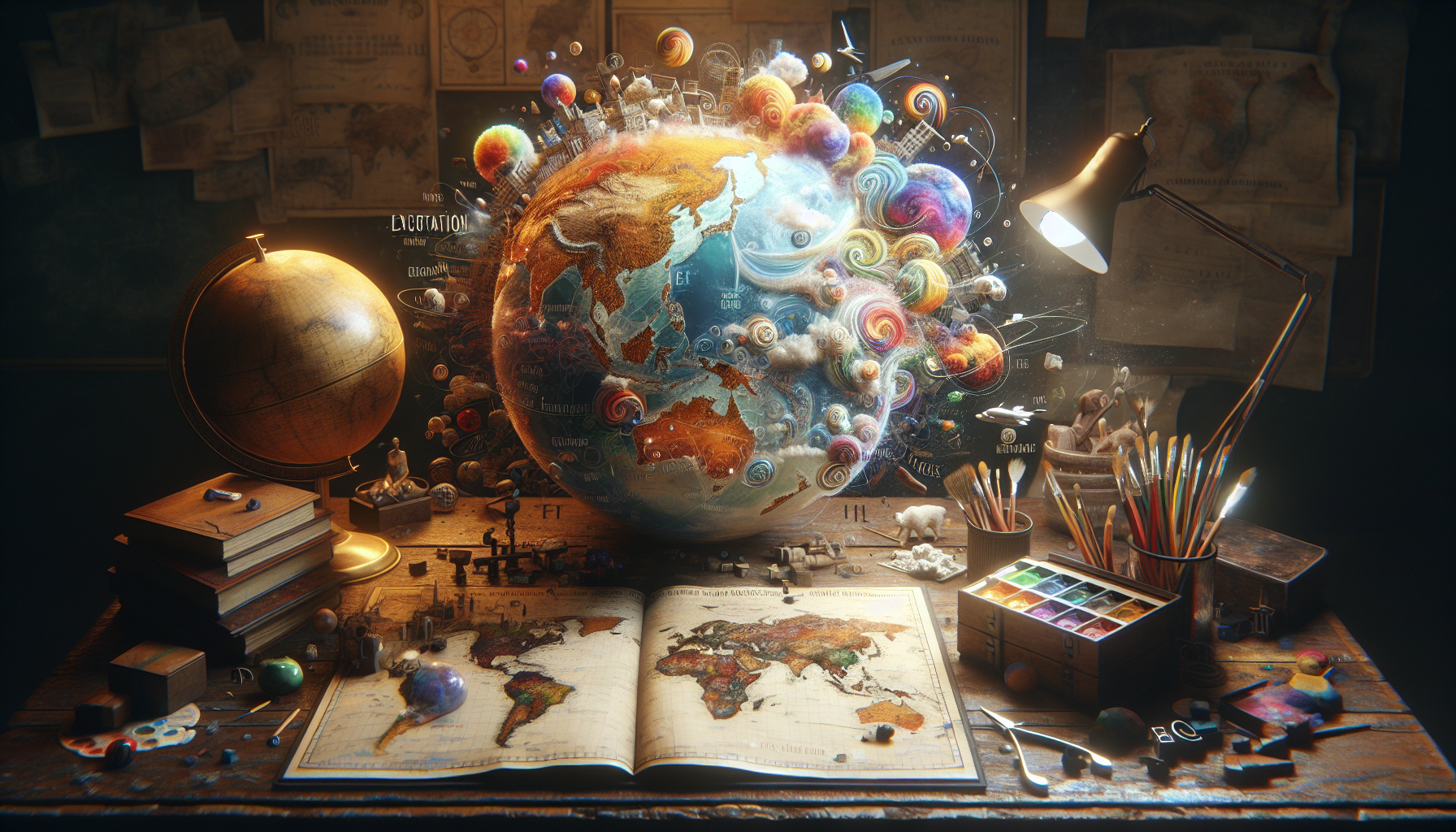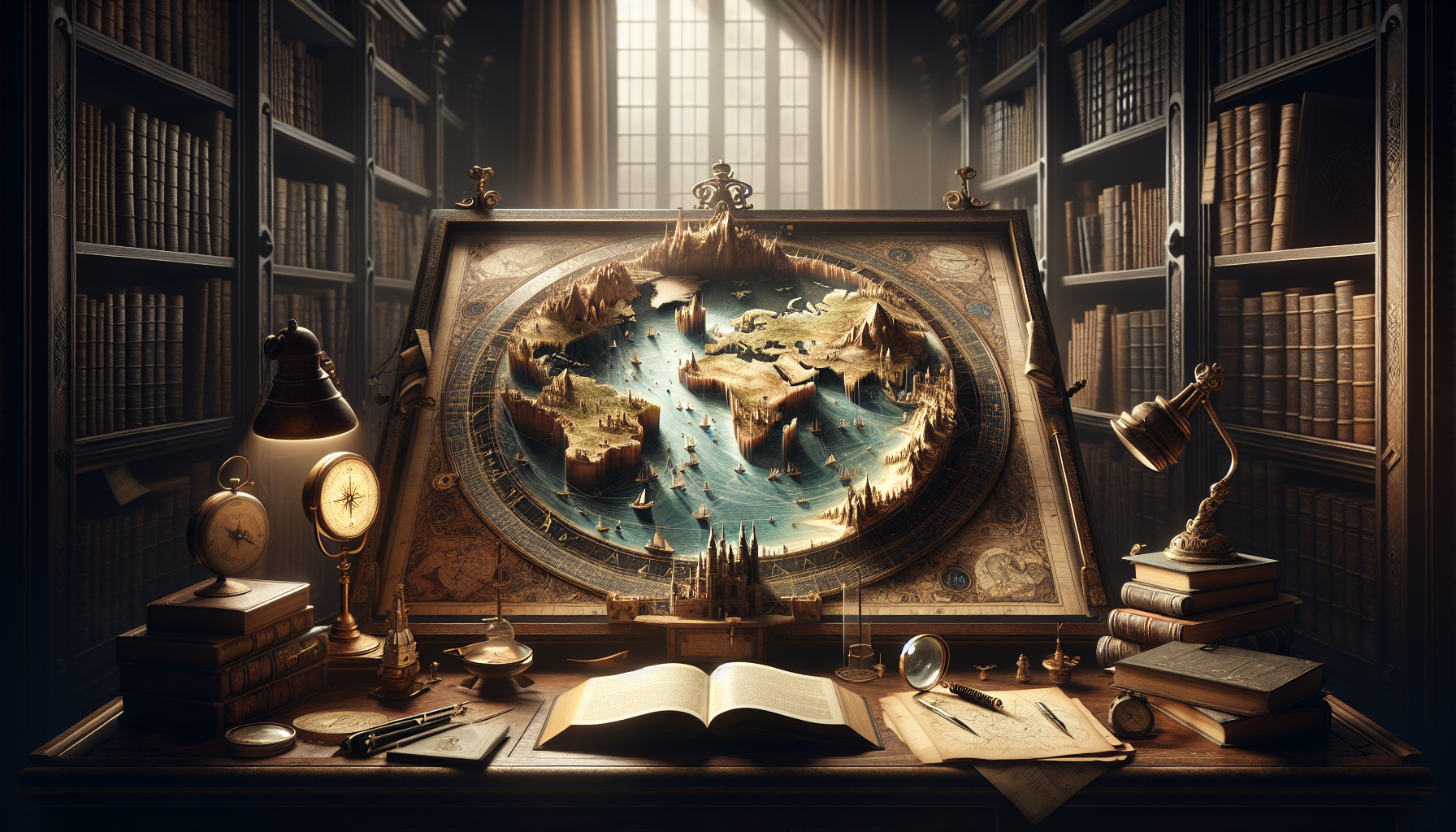In the vast realm of storytelling, few elements capture the imagination quite like a well-crafted map. Whether unfurling an ancient scroll that reveals hidden kingdoms or poring over a modern digital rendering of a fictional metropolis, maps have the power to transport us to places beyond our everyday experiences. They serve as gateways to uncharted territories, inviting us to embark on adventures and explore the unknown. Fictional maps, in particular, hold a special kind of magic. They are not merely illustrations; they are integral components of storytelling that breathe life into the worlds we cherish in books and films. 🌍📚
The allure of fictional maps lies in their ability to make the intangible tangible. They provide a framework upon which entire narratives are constructed, guiding both characters and readers through complex landscapes filled with intrigue and wonder. Imagine J.R.R. Tolkien’s Middle-earth without the winding paths that lead to Mordor, or the land of Westeros without the intricate detailing of its Seven Kingdoms. These maps do more than chart geography; they define the very essence of the story’s universe, offering insights into the cultures, histories, and conflicts that shape the narrative. In this exploration of fictional cartography, we will delve into how these maps are meticulously crafted to enhance storytelling, the artistic and technical skills involved, and the cultural impact they have on audiences worldwide.
Fictional maps are not just the work of artists; they are the collaborative efforts of writers, cartographers, and filmmakers who strive to create a seamless blend of narrative and visual artistry. Each line drawn and each landmark placed is deliberate, serving as a narrative tool that enhances plot development and character journeys. As we journey through this article, we will uncover the processes behind creating these captivating maps, from initial concept sketches to the intricate detailing that brings them to life. We’ll also explore how technological advancements have influenced the evolution of map-making in modern storytelling, offering new dimensions and possibilities for world-building.
Finally, we will reflect on the cultural significance of these maps and their role in shaping the way we consume and interact with stories. Fictional maps have become iconic symbols within pop culture, transcending the pages and screens to become beloved artifacts in their own right. They ignite the imagination of fans, inspiring countless fan theories, artworks, and even real-world explorations. By the end of this article, you’ll not only have a deeper appreciation for the artistry and craft behind fictional maps but also a renewed sense of wonder for the worlds they depict. So, prepare to set sail on a voyage through the enchanting landscapes of fictional cartography, where every map is a treasure map leading to adventures untold. 🗺️✨
The Enchanting World of Fictional Maps
Fictional maps have captivated readers and moviegoers for generations, offering a gateway to worlds that are at once fantastical and familiar. These maps are more than just a backdrop; they are an integral part of storytelling, helping to shape the narratives and invite the audience into a richly imagined world. Whether it’s the sprawling landscapes of Middle-earth or the intricate cityscapes of King’s Landing, these maps provide a framework that enriches the story and enhances the reader’s experience. They serve as a visual guide that helps readers and viewers navigate through the complex terrains of imaginary realms, creating a sense of place that is both vivid and immersive.
At the heart of every great story is a setting that feels alive. Fictional maps contribute to this liveliness by giving tangible form to the settings. These maps allow authors and filmmakers to establish a sense of scale, distance, and geography, which can be pivotal to the story’s plot and character development. For instance, J.R.R. Tolkien’s maps of Middle-earth offer insights into the epic journey of the Fellowship, illustrating the immense challenges they face as they traverse diverse landscapes from the Shire to Mordor. Similarly, the maps in George R.R. Martin’s “A Song of Ice and Fire” series reveal the political tensions and alliances that underpin the narrative, offering readers a deeper understanding of the world’s complexity.
Moreover, fictional maps serve as a creative tool for authors and filmmakers, enabling them to craft worlds that are not only visually appealing but also thematically resonant. These maps often reflect the cultural, historical, and social dynamics of the fictional worlds, providing a visual representation of the story’s underlying themes. For example, the map of Narnia in C.S. Lewis’s series not only charts the physical landscape but also reflects the moral and ethical dimensions of the narrative. The use of maps in storytelling is a testament to the power of visual storytelling, demonstrating how a simple illustration can enhance the reader’s engagement and understanding of the narrative.
Creating Fictional Maps: The Art and Science
The process of creating fictional maps is both an art and a science, requiring a careful balance of creativity and technical skill. Authors and cartographers must consider a range of factors when designing these maps, from the geography and climate to the political boundaries and cultural landmarks. This process often involves extensive research and planning, as creators seek to build worlds that are consistent and believable. The result is a map that not only complements the narrative but also stands on its own as a piece of art.
In many cases, fictional maps are inspired by real-world geography. Authors may draw upon their knowledge of actual landscapes to create maps that feel authentic and grounded. For example, Tolkien’s maps of Middle-earth were influenced by the landscapes of Northern Europe, with their rugged mountains and dense forests. By incorporating elements of real-world geography, creators can lend an air of authenticity to their fictional worlds, making them more relatable and engaging for the audience.
Another critical aspect of map creation is the use of symbolism and iconography. Fictional maps often feature unique symbols and icons that represent different elements of the story, such as cities, landmarks, and territories. These symbols serve as a visual shorthand, allowing readers to quickly identify and understand key aspects of the map. For instance, the map of Westeros in “A Game of Thrones” uses distinct icons to represent the various noble houses and their territories, providing readers with a visual guide to the complex political landscape of the series. This attention to detail enhances the map’s functionality and contributes to the richness of the fictional world.
The Role of Technology in Map Creation
With advancements in technology, the creation of fictional maps has become more accessible and sophisticated. Digital tools and software allow creators to design maps with greater precision and flexibility, offering new possibilities for storytelling. Programs like Photoshop and GIS software enable authors and artists to experiment with different styles and layouts, resulting in maps that are not only detailed but also visually stunning. These tools also allow for the integration of interactive elements, such as clickable icons and animated features, which can enhance the reader’s engagement with the map.
The rise of digital platforms has also expanded the reach of fictional maps, allowing creators to share their work with a global audience. Online communities and forums provide a space for fans to discuss and analyze fictional maps, fostering a sense of community and collaboration. This engagement can lead to new interpretations and insights, enriching the reader’s understanding of the fictional world. As technology continues to evolve, the potential for innovation in map creation remains vast, offering exciting opportunities for authors and filmmakers to push the boundaries of storytelling.
For an insightful look at how technology is used in the creation of fictional maps, check out this video: “The Making of Middle-earth’s Map” on the channel Maps & Legends.
Comparative Analysis: Iconic Fictional Maps
To understand the impact of fictional maps on storytelling, it’s helpful to compare some of the most iconic maps from literature and film. Each map offers a unique perspective on the world it represents, highlighting different aspects of the narrative and contributing to the story’s overall impact. Below is a table that compares key features of three iconic fictional maps:
| Map | Origin | Key Features | Impact on Story |
|---|---|---|---|
| Middle-earth | The Lord of the Rings (J.R.R. Tolkien) | Detailed geography, diverse landscapes, cultural landmarks | Enhances epic journey, reflects themes of adventure and heroism |
| Westeros | A Song of Ice and Fire (George R.R. Martin) | Political boundaries, iconic symbols, dynamic territories | Illustrates political tensions, provides context for character alliances |
| Narnia | The Chronicles of Narnia (C.S. Lewis) | Mythical creatures, symbolic landscapes, moral dimensions | Reflects moral themes, enhances allegorical elements |
These maps demonstrate the diversity and depth that fictional cartography can bring to storytelling. Each map is crafted to reflect the unique characteristics of its world, offering readers a visual representation of the story’s setting and themes. As you explore these maps, consider how they shape your understanding of the narrative and contribute to the story’s immersive quality.
The Legacy of Fictional Maps
The influence of fictional maps extends beyond the confines of individual stories, leaving a lasting impact on the broader landscape of literature and film. These maps have become cultural icons in their own right, inspiring countless adaptations, fan creations, and academic studies. They serve as a testament to the enduring power of visual storytelling, illustrating how a simple illustration can captivate the imagination and enrich the narrative experience.
Fictional maps have also played a significant role in the evolution of genre fiction, particularly in fantasy and science fiction. The detailed maps found in these genres help to establish a sense of place that is crucial to the story’s believability and immersion. By providing a visual framework for the narrative, these maps allow authors to build worlds that are both imaginative and coherent, inviting readers to explore new dimensions of storytelling. The legacy of fictional maps is one of creativity and innovation, demonstrating the limitless potential of the human imagination.
For further exploration of the legacy and impact of fictional maps, watch the informative video below:
Conclusion
In conclusion, the exploration of fictional maps in literature and film reveals a captivating intersection between creativity and cartography, where the boundaries of imagination are expanded through intricate, often meticulously detailed worlds. This article has journeyed through the enchanting realms of fictional cartography, shedding light on how these imaginative landscapes serve not only as backdrops for storytelling but also as integral elements that enrich narratives and engage audiences on a profound level.
Throughout our exploration, we have seen how fictional maps are more than mere illustrations; they are gateways to immersive experiences. They anchor stories in a semblance of reality, providing readers and viewers with a sense of place and orientation within a fictional universe. For instance, the sweeping landscapes of J.R.R. Tolkien’s Middle-earth or the whimsical terrains of J.K. Rowling’s Hogwarts are etched into our collective consciousness, demonstrating the power of maps to transport us beyond the confines of the real world.
We’ve also delved into the meticulous craftsmanship that goes into creating these maps. Authors and filmmakers often collaborate with artists to ensure that every river, mountain, and city aligns with the narrative’s needs, adding layers of depth to the story. This process not only enhances the believability of the world but also allows for intricate plot developments that hinge on geography. Whether it’s the strategic importance of a hidden valley or the perilous journey across treacherous seas, maps play a crucial role in shaping the storyline.
Furthermore, fictional maps foster a deeper connection between the audience and the narrative. They invite readers and viewers to engage with the story actively, encouraging them to explore and imagine beyond the written word or the visual frame. This participatory aspect can lead to a more personal and meaningful experience, as audiences chart their courses through these invented worlds, discovering hidden facets of the story and forming unique interpretations.
The significance of fictional maps extends beyond mere entertainment. They hold educational value, offering insights into geography, history, and even cultural anthropology, albeit through a fictional lens. By engaging with these maps, audiences can develop a better understanding of spatial relationships and the importance of geography in human endeavors, albeit in a fictional context. This can spark curiosity and inspire further exploration of real-world cartography and geography.
In today’s digital age, fictional maps have found new life through interactive platforms and online communities. Fans create and share their own versions, expanding upon the original works and breathing new life into beloved stories. This collaborative spirit exemplifies the enduring impact of fictional cartography, as it continues to inspire creativity and community engagement.
The magic of fictional maps lies in their ability to transport us to worlds beyond our own, to places where the only limits are those of our imagination. They remind us that storytelling is not confined to words or images alone but is enriched by the landscapes we envision. As we close this exploration, it is important to acknowledge and celebrate the artists, authors, and creators who painstakingly bring these maps to life, allowing us to traverse the uncharted territories of fantasy.
In light of this, I encourage you, dear reader, to take a moment to appreciate the fictional maps you encounter. Consider the thought and creativity that went into their creation and how they enhance your experience of the story. Share your favorite maps with friends and engage in discussions about the worlds they represent. Perhaps even try your hand at creating your own fictional map, allowing your imagination to roam free and chart new worlds.
In the spirit of discovery and creativity, let us continue to explore and appreciate the magical worlds crafted through the art of fictional cartography. By doing so, we not only honor the legacy of these imaginative landscapes but also fuel our own creativity and sense of wonder. 🌍📚✨
For further exploration into the fascinating world of fictional maps, you might consider visiting National Geographic’s exploration of fictional worlds or Cartographer’s Guild, where enthusiasts gather to discuss and share their creations.
Thank you for joining us on this journey. We look forward to hearing your thoughts and insights, so please feel free to leave a comment below. And if you found this article inspiring, don’t hesitate to share it with fellow enthusiasts who might also appreciate the magic of fictional maps. Happy exploring!
Toni Santos is a digital cartographer, visual thinker, and curator of the wonderfully weird. At Aysapp, he dives into the wild world of bizarre maps, imagined geographies, and alternative cartographic realities, offering a fresh perspective on how we see — and feel — the world around us.
His work is rooted in the belief that maps are more than navigation tools. They’re portals to perception, memory, imagination, and even myth. From distorted historical charts to surreal landforms, conspiracy atlases, and AI-generated worldbuilding, Toni crafts and collects maps that challenge logic and spark curiosity.
With a background in storytelling, art, and symbolic exploration, Toni uses Aysapp as a platform to reveal forgotten places, invisible borders, and reimagined realities. His creations ask questions like: What if the world was upside down? What if maps told emotional truths instead of geographic ones?
As the creator behind Aysapp, he’s on a mission to inspire curiosity, encourage creative thought, and explore the intersection between imagination, culture, and spatial storytelling — one strange map at a time.
🌀 His cartographic universe explores:
-
Unreal but meaningful landscapes
-
Emotion, memory, and myth as geography
-
Maps that distort to reveal hidden truths
Whether you’re a fan of fantasy lands, a map collector, a curious traveler, or someone who loves the unusual, Toni invites you to get lost — on purpose — in the most extraordinary corners of cartographic imagination.




